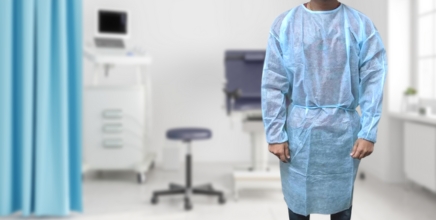Disposable Gowns
Disposable Gowns are perfect for putting a barrier between you and the outside world. These useful gowns help combat dirt, dust, debris and more!
Enjoy free shipping on all safety supplies now!

Types of Disposable Gowns
About Our Disposable Gowns
In the dynamic world of health and safety, isolation gowns are a cornerstone in protecting professionals across various industries. PSBM's range of disposable gowns offers unparalleled protection, combining innovative materials with cutting-edge design to ensure every user's safety and comfort. These gowns are specifically crafted to meet the rigorous demands of medical, laboratory, and industrial environments, providing a barrier against contaminants and infections.
Types of Disposable Gowns
PSBM disposable gown collection includes options designed to cater to diverse requirements and settings.
i) Polyethylene Isolation Gowns
Polyethylene gowns are designed for situations requiring robust fluid resistance. These gowns feature a smooth surface that repels liquids efficiently, making them ideal for high-risk environments where exposure to fluids is common.
ii) Polypropylene Isolation Gowns
PSBM polypropylene gowns offer breathability and comfort, perfect for extended wear. Lightweight yet durable, these gowns provide excellent protection and are suitable for a variety of low to moderate-risk settings.
Benefits of Disposable Gowns
Isolation gowns are essential for infection control strategies, providing a physical barrier that protects healthcare workers, patients, and other individuals from the transfer of microorganisms and body fluids. The disposability of these gowns adds a layer of convenience, significantly reducing the risks of cross-contamination associated with reusable garments and ensuring compliance with hygiene standards.
Features of Disposable Plastic Gowns
PSBM disposable plastic gowns are crafted with features that enhance their protective capabilities. These include elastic cuffs, tie-back closures, and waterproof materials that ensure maximum coverage and protection. The gowns are also designed for a universal fit, accommodating all body sizes comfortably.
Applications of Disposable Gowns
These gowns are versatile and can be used in various settings, including hospitals, clinics, laboratories, and other environments where protection from infection is necessary. They are also increasingly used in non-medical industries, such as food processing and manufacturing, where cleanliness and sanitation are paramount.
Why Choose PSBM’s Disposable Gowns PPE
Choosing PSBM disposable gowns means opting for safety, efficiency, and innovation. Our products are rigorously tested and certified to meet global standards for personal protective equipment (PPE). With a focus on sustainability, our gowns are also produced with eco-friendly materials and processes, ensuring that we not only protect our customers but also the environment.
FAQs:
Q1. Can disposable gowns be reused?
Ans. No, disposable gowns are designed for single use only to prevent cross-contamination. They should be disposed of properly after each use.
Q2. What is the purpose of disposable gowns?
Ans. Disposable gowns provide a protective barrier that helps prevent the transfer of microorganisms, body fluids, and particulate matter, enhancing safety in healthcare settings and other industries.
Q3. What material is used in disposable gowns?
Ans. Our disposable gowns are typically made from polyethylene or polypropylene. These materials are chosen for their ability to block liquids and particulates effectively.
Q4. How do you store old gowns?
Ans. Old gowns, if not contaminated, should be disposed of in accordance with your facility's regulations, usually in designated biohazard containers. If recycling is an option, follow specific protocols to ensure safe handling.
Q5. Where should a disposable gown be placed after use?
Ans. After use, disposable gowns should be carefully removed and immediately placed in a designated biohazard waste container to avoid any risk of contamination.


